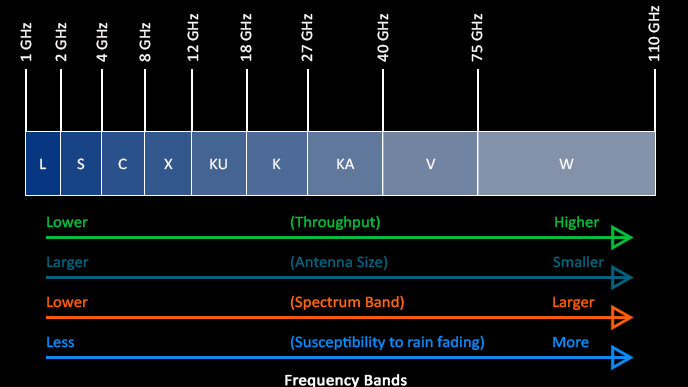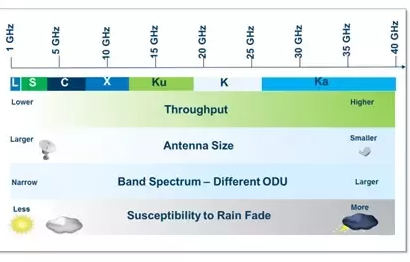K-band operates at 18-27 GHz, ideal for radar; Ka-band at 27-40 GHz, offers higher bandwidth for satellite communications.
Frequency Range
The K-band and Ka-band are both integral parts of the electromagnetic spectrum. They both have distinct frequency ranges, as well as distinct technological applications. The K band ranges from 18 to 27 GHz. One notable use is with the radar guns the police use to measure the speed of your car while driving: these are often K band because they present a good tradeoff between range and resolution. The time it takes to bounce a signal from a fast car moving away and then coming closer to a radar gun requires that the gun have a certain minimum resolution accommodating the range of speeds they are measuring. The K band provides enough signal to get a lock on a target at 1,000 ft away with resolution enough to nail on its speed.
Ka band meanwhile runs from 27 to 40 GHz, all 10 Gigahertz of bandwidth. For similar reasons of bandwidth and signal strength, it is used in the satellite systems today: satellite internet is usually Ka band in order to give its users greater bandwidth and download speeds. The high frequency of the Ka band permits it to deliver data at far greater speed than lower frequency bands. The higher frequency band, likewise, also allows for the bandwidth necessary for the transmitting video media over the ‘net: broadband usually implies at least 4Mbps up stream and down stream, which cable, by contrast, is not traditionally capable of—that degree of throughput allowing not only for the downloading of large files, but instantaneous feedback on their contents.
While the choice might seem obvious given the use case, it is not just a matter of application. Ka is also not as particularly well suited for the atmosphere as the lower frequency K-band: it is more “attenuating,” i.e. the signal is weakened more by going through the atmosphere. This further makes it a candidate for the drier Ka-band for satellite internet: it requires a special, expensive moisture-resistant dish in order to survive the rain.

Applications
The K-band and Ka-band are valuable in very different and significant ways, but only in particular applications of their technologies in different sectors. Firstly, the K-band is with a frequency range of 18 to 27 GHz. For example, radar systems used by the police for speed enforcement are usually equipped with K-band radar. In this application, technology must accurately detect a car in the flow properly and determine its speed. In these systems, the performance advantages of the K-band are best illustrated because the K-band has an optimal wavelength that provides the best balance between the distance over which a radar can detect a vehicle and the ability to resolve the radar’s returning signal to identify its speed . . An additional application of the K-band in this area is related to airports that use K-band radar to track the weather. This is critical for airplane landing, flight, scheduling, and other safety aspects. The wavelength of the K-band is well-suited for efficiently penetrating moderate precipitation, and meteorologists and airports receive excellent information to optimize critical operations and provide a high level of safety.
Secondly, the Ka-band is with a frequency range of 27 to 40 GHz, and its value in myriads broadens and acquires its most significant and best applications, primarily in the satellite communication area. Satellite TV providers use Ka-band to provide high-quality TV to their customers . The higher frequencies of this band tend to provide more bandwidth to the provider. On the end-users’ side, this results in better quality of both video and audio of the TV signal. An additional beneficial value and application of the Ka-band is related to the broadband rural and remote internet that provides customers with satellite technology that can provide 100 Mbps. In these areas, providing internet in another way, where it does not exist, is too expensive for cable companies, as well as other broadband companies that do not have the spectrum assurance that these companies have, so they cannot provide it. On the other hand, satellite internet with the Ka-band can overcome these challenges.

Atmospheric Absorption
Тhe question of whether atmospheric absorption has an impact on the performance of K-band and Ka-band frequencies is significant for both radar and satellite applications. The K-band, which operates at frequencies ranging from 18 to 27 GHz , generally enjoys a moderate susceptibility to the local atmosphere, such as fog, rain, and clouds . While this does affect the general reliability of this frequency, it would not have a severe effect on the operational capacity used to power traffic radar systems and weather radars at airports . The systems designed for such use are by necessity capable of handling a wide range of weather conditions, so while heavy rain would reduce their range, it would not take them out of commission.
In contrast, the Ka-band, which ranges from 27 to 40 GHz, experiences much stronger atmospheric absorption . The higher frequency of Ka-band compared to K-band makes it much likelier for signals in the frequency to be significantly degraded by the interaction with raindrops and the water vapor in the air . Such ‘rain fade’ is a significant problem for satellite communication, which relies on its point-to-point setup between satellites in orbit and ground receivers . In the middle of a heavy rainstorm, satellite signals from the Ka-band can be lost, shutting down satellite television service or broadband internet connections from these satellites . As a result, these more advanced technologies must come equipped with the ability to modulate their frequencies and power outputs to ensure that a solid signal is received and successfully transmitted through the imperfect conditions. Such capabilities increase the cost of Ka-band solutions, but the significant data throughput capacity and general efficiency of the frequencies enhance their value enough to warrant the increased expenditure. For satellite television service companies providing Ka-band connection, this results in higher costs for both the necessary terminal adapters for each end-user and the data capacity required to provide smooth service.
Bandwidth
K-band and Ka-band’s applications depend on their respective bandwidth capabilities. The K-band utilizes channels that are 250 MHz wide and operates in a range between 18 to 27 GHz. This bandwidth is sufficient for some applications including inexpensive and small radar systems for speed detection installed in police cars, and meteorological radars. In the former application, the bandwidth is sufficient in conjunction with the range of the frequencies applied. Notably, the radar needs to have high enough frequencies for the reflections from the car and ground to be processed in real time. Meteorological radars also routinely operate in this band . In combination with the frequency utilized, the Ka band’s band sufficiently spectrally separates different resonant backscattering from different atmospheric phenomena. However, an increase in range in this case would have positively impacted the resolution of the radar.
The bandwidth utilized by the Ka-band is significantly larger at 500 MHz and it is used between 27 to 40 GHz. The application of a band at this frequency is appropriate for the most sophisticated satellite communication bandwidths. An example of such as application is the provision of broadband internet by space telecommunication companies such as Viasat . Such bandwidths are capable of enabling speeds equivalent to downloading large files quickly . Consequently, they can enable data intensive applications, internet browsing, large-scale online communications, and high definition video streaming. They also offer higher quality of service to users in video streaming and television broadcasting. Lower bandwidths require intense compression of the video images which can lead to distorted image quality and other compression-related artifacts. However, all these applications require significant capital input to enable deployment of the extremely complex and expensive technology needed to utilize the bandwidth.






